Services on Demand
Journal
Article
Indicators
-
 Cited by SciELO
Cited by SciELO -
 Access statistics
Access statistics
Related links
-
 Cited by Google
Cited by Google -
 Similars in
SciELO
Similars in
SciELO -
 Similars in Google
Similars in Google
Share
DYNA
Print version ISSN 0012-7353On-line version ISSN 2346-2183
Dyna rev.fac.nac.minas vol.78 no.170 Medellín Dec. 2011
MOTOR CURRENT SIGNATURE ANALYSIS AND NEGATIVE SEQUENCE CURRENT BASED STATOR WINDING SHORT FAULT DETECTION IN AN INDUCTION MOTOR
DETECCIÓN DE CORTO CIRCUITO EN EL ESTATOR DE UN MOTOR DE INDUCCIÓN BASADA EN MCSA Y LA CORRIENTE DE SECUENCIA NEGATIVA
SILVIA OVIEDO
MSc. Escuela de Ingeniería Mecánica, Universidad Industrial de Santander, Bucaramanga-Colombia, siljuovi@uis.edu.co
JABID QUIROGA
MSc . Profesor Asociado, Ingeniería Mecánica, Universidad Industrial de Santander, Bucaramanga-Colombia, jabib@uis.edu.co
CARLOS BORRÁS
PhD. Profesor Asociado, Ingeniería Mecánica, Universidad Industrial de Santander, Bucaramanga-Colombia, cborras@uis.edu.co
Received for review September 6th, 2010, accepted March 14th, 2011, final version March 25th, 2011
ABSTRACT: In this paper, negative sequence analysis and motor current signature analysis (MCSA) based approaches are applied to perform short fault detection of a single phase winding in an induction motor. The fault detection is carried out using the negative sequence analysis and spectral analysis of current signals. An experimental analysis is presented, showing the advantages and drawbacks for each method implemented. Tests are performed in a 2 Hp induction motor dedicated to this type of study. Experimental results show variations in the fault indicator in both methods when the motor is running under different load conditions. Although the negative sequence current method demands simultaneous three phase current sensing, it presents better performance for short fault detection and provides a fault severity level estimation.
KEYWORDS: Fault detection, stator winding short circuit, sequence components, MCSA
RESUMEN: En este artículo se utilizan las técnicas MCSA y componentes secuenciales para la detección de cortocircuito de una fase del bobinado del estator de un motor de inducción. La detección de esta falla se realiza usando el análisis de corriente de secuencia negativa y del espectro de la señal de corriente. Se presenta un análisis experimental mostrando las ventajas y desventajas de cada método implementado. Se realizan pruebas en un banco de motores de inducción de 2 hp dedicado para este tipo de estudios. Los resultados experimentales muestran variaciones en el indicador de falla en ambos métodos cuando el motor está operando en diferentes condiciones de carga. Aunque la corriente secuencial negativa requiere el uso de sensores de corriente en las tres fases del motor, esta técnica presenta un mejor desempeño en la detección del cortocircuito del bobinado y proporciona un valor estimado de la severidad de la falla.
PALABRAS CLAVE: Detección de fallas, cortocircuito en el bobinado del estator, componentes secuenciales, MCSA
1. INTRODUCTION
Early detection of a stator short circuit fault in motors is critical in preventing damage to the machine. Fast and accurate diagnosis of these types of faults allows actions to be taken to protect the power system and the machine. Recently, there has been considerable interest in fault detection and diagnosis techniques. The subject of a fault detection and diagnosis system (FDD) has been the focus of many investigations. Different invasive and noninvasive methods have been reported for incipient and permanent fault detection. Noninvasive methods are based on establishing the system condition by analyzing the information obtained outside the equipment, such as terminal and environmental measurements; furthermore, noninvasive techniques are more economical and therefore preferred. Usually, the detection schemes and the parameter settings developed are very specific to the system under investigation. Fault detection methods can be further grouped into: (a) model based, (b) knowledge based, and (c) signal based methods.
Signal based methods such as spectral analysis, instantaneous power FFT, bispectrum, wavelet analysis, sequence analysis, etc., do not incorporate any model and rely on features associated with the fault present in the measured variables. Although simple, signal-based methods require high-quality sensors (an acquisition system) in order to be used for detection. Fault detection associated with signal based methods consists basically in a pattern recognition method.
Generally, FDD schemes for motors have concentrated on sensing specific failures in one of the three components: the rotor, the stator, and the bearings. In addition, the most common fault modes are categorized into two types: mechanical and electrical faults. Mechanical faults include bearing faults, air gap, eccentricity, and faults caused by overheating. Electrical faults consist of faults caused by winding insulation problems and some rotor faults.
Different FDD methods have been proposed for each type of motor fault. Even though thermal and vibration monitoring have been utilized widely, most of the recent research has been focused on electrical characteristic of the motor with emphasis on inspecting the stator current of the motor [1-2].
In the literature, work on the fault detection of stator winding shorts of electric machines is primarily focused on induction motors using either motor current signature analysis (MCSA) or negative sequence component (NSC). The absence of publications in detection of stator winding faults using MCSA and NSC simultaneously prevents a systematic comparison of the proposed methods.
In [3], a comparative analysis is provided for the online diagnosis of a stator winding short circuit in induction motors. The authors compared several diagnostic methods in terms of diagnostic efficiency and requirements for practical implementation. Among all the techniques analyzed, those based on the sequence components are considered to be the most promising. The use of MCSA in stator winding short circuit under different load conditions is proposed [4-7]. Results showed the activation of different harmonics depending on the test carried out for each specific study. Variations in the fault indicator jeopardize any attempt to use the activation of specific current harmonics as a fault indicator. In tests performed [4] in an uncoupled induction motor under 2 %, 4 %, and 32 % of shorted winding in one phase showed a maximum increase of 15 dB (32 % fault) in a 75 Hz component of normal condition. The presence of fault coincident harmonics linked to eccentricity when the load is connected is claimed, which does not make it possible to distinguish one effect from the other. Similar results are obtained for an uncoupled machine [5], claiming a 15 dB increase in 54.5 Hz, and 154.5 Hz from a healthy condition to the non- specified most severe fault condition. A decrease in the amplitude of the fault harmonics when the machine load is increased is also noticed [5-6]. Furthermore, the fault indicator presents a minor increase in the first stages of faulty condition which means the indicator has low damage sensitivity. .
On the other hand, the experiments carried out in this study using an induction motor under fault condition show a significant increase in the negative sequence components of the current under both incipient and severe faults. Although the effect of other sources of asymmetries such as inherent motor imbalance and instrumentation is not considered in this paper, the experimental implementation of the negative sequence current does permit a real assessment of the machine's condition.
2. METHODOLOGY
2.1 Stator Winding Short Circuits in Electric Machines
Statistics show that stator winding faults constitute the largest portion of electrical faults [8]. The stator winding short circuit fault in electric motors usually starts as an undetected insulation failure between two adjacent turns, and then develops into a short circuit isolating a number of turns [9]. Though starting with incipient turn-to-turn short circuits, undetected small insulation failures can deteriorate and accumulate rapidly. The resulting high current may eventually lead to loss of a phase winding, phase-to-phase or phase-to-ground faults. The incipient winding faults in a single stator coil may have relatively little effect on motor performance but may affect overall motor reliability, availability, and longevity [10].
The causes of the stator winding faults can be summarized as follows [11-12].
- During the motor startup, the inter turn insulation suffers from a transient overvoltage.
- Unbalance and overvoltage cause increases in the winding temperature and deterioration of the insulation.
- Loose bracing for end winding.
- Short circuit and electrical discharges.
- Aggressive environments such as those with contamination, moisture, chemicals, and high temperatures weaken the insulation.
2.1.1 Negative Sequence Component
The method of symmetrical components is a mathematical technique to describe unbalanced power systems. For a three phase system, the sequence components of the current are described by (1)
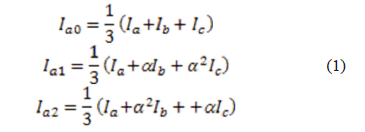
where Ia0, Ia1, and Ia2 are the zero, positive, and negative sequence currents, respectively; and a is a phase rotation operator equivalent to ej2p/3 or 120°. A balanced set of three phase currents only contains the positive sequence current component, the negative sequence current is an indication of the amount of unbalance (asymmetry) in the system, and the zero-sequence current is a measure of the amount of current not returning through the phase conductors [13].
Asymmetries in the 3j quantities of the electric machines may arise due to a variety of reasons: (a) stator winding short circuits, (b) inherent machine and instrumentation asymmetries, (c) load fluctuations, and (d) unbalanced supply voltages. Such asymmetries are reflected in the negative sequence component. In this study, the negative sequence of the current signal is employed as a fault indicator, which is obtained for the induction motor using (1). Both analytical and experimental results have demonstrated an increase in negative sequence current under stator winding short circuits [14].
2.1.2. Motor Current Signature Analysis
Motor current signature analysis (MCSA) is a noninvasive fault detection technique. It is frequency information based and capable of detecting stator winding shorts. The MCSA is performed by monitoring the activation of some specific fault condition related to harmonics. Theoretical studies have proven that the following equation provides the components in the air gap flux waveform, and therefore in the current waveform that is a function of shorted turns [7]:

where fst are the frequency components associated with shorted turns, f1 is the supply frequency, p is the number of pole pairs, n = 1, 2, 3 ..., k = 1, 2, 3 ..., and s is the motor slip.
3. EXPERIMENTAL RESULTSB
This section presents the experimental results obtained using both the MCSA and NSC approaches to perform the fault detection of a stator winding short circuit in an induction motor. A series of tests are designed to evaluate the detectability and the severity level of the emulated stator winding short faults using the proposed methodologies, both with and without load fluctuation. Three cases are presented here for each approach.
A 2 Hp, 440/220V, 1800 rpm, 4 pole, 60 Hz motor is used for the tests. In the proposed experimental setup, the induction motor is specifically designed for fault detection and diagnosis purposes, especially the stator winding faults. To emulate the fault conditions, the stator windings of the induction motor have been reconstructed. The windings in one phase of the motor are equipped with several accessible taps so that a stator winding short type fault of varying severity can be introduced, corresponding to 2 %, 5 % and 10 % shorted turns. Figure 1 shows the implemented test bench. In order to emulate real operating conditions, the load is applied to the induction motor obtaining 75 % and 85 % of the rated current as expected in real applications. A 220 VDC shunt generator is used as a load; the different load conditions are created by connecting variable resistive loads to it.
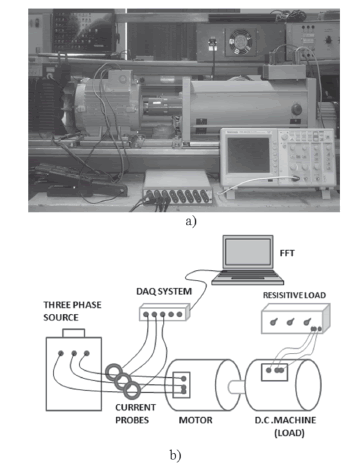
Figure 1. a) Experimental test bench b) test bench scheme
The data acquisition system is developed using Matlab/SimulinkÒ with WinDaq software as an interface to the hardware. Algorithms utilized in the implementation of MCSA and NSC are developed in Matlab/SimulinkÒ. A DI-730 data acquisition system from DataQÒ is used to display and record the three line currents from a three hall effect based on AC/DC current probes.
A series of tests are designed to demonstrate the detectability and diagnosis capability of the emulated stator interturn short circuit fault using MCSA and NSC with and without load fluctuation.
In the proposed MCSA and NSC based fault detection system, the data acquisition allows for the sampling of three phase line currents INS (t), where NS represent a nonstationary signal. The signals are sampled with a 5 kHz sampling frequency and the data are used in both approaches simultaneously. The IfNS(t) are then used to generate the spectrum and the negative sequence current fault indicator Ia2 according to (1) in the Matlab and Simulink environments.
3.1 Motor Current Signature Analysis approach
The MCSA is a frequency information based technique in which one or various specific frequencies are used as fault indicators. Because this fault detection scheme relies on the frequency information of the current, an appropriate spectral algorithm must be used to identify the feature associated to the fault. The Welch spectrum implemented in MatlabÒ is used in this study. This technique provides a substantial noise reduction, facilitating the fault-associated feature recognition.
Case 1. MCSA for stator winding short with no load coupled
This experiment is performed to demonstrate the detectability of a winding short fault using the MCSA under no load condition. Figure 2 shows the spectral components of the current for the induction motor running for no load condition for a 500-600 Hz bandwidth. The Welch spectrum between 0-2500 Hz shows a single fault frequency activated around 540 Hz, among all the fst possibilities. Taking into account the previous result, the activation of frequencies around 540 Hz under higher load conditions is expected.
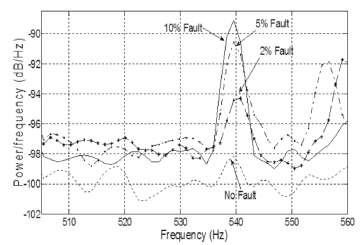
Figure 2. Welch periodogram for no load coupled
Case 2. MCSA for stator winding short with 75 % load coupled
Another experiment is carried out in conditions similar to Case 1, with a coupled load of 75 % of the motor rated current, and for fault conditions of 2 %, 5 %, and 10 % shorted windings. This test is used to prove the fault detectability using the purposed methodology under a higher load condition. As expected, based on Case 1, the 540 Hz frequency spectral amplitude shows a consistent behavior under this load condition. Figure 3 shows the range between 500 and 600 Hz with the corresponding excited frequency under fault condition. In the same figure, a maximum variation around 8 dB between normal condition and 10% fault condition can be appreciated. Nevertheless, this variation can be also observed in other fault nonrelated frequency components, and for that reason, the sensitivity of this fault indicator is not satisfying for the authors when monitoring the condition of an induction motor.
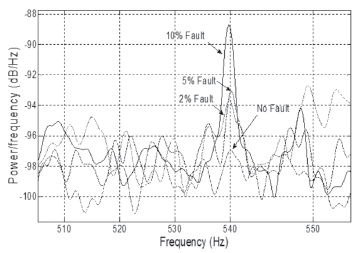
Figure 3. Welch periodogram for 75 % load coupled
Case 3. MCSA for stator winding short with 85 % load coupled
A third experiment is carried out using a load corresponding to 85 % of the motor rated current, and the same shorted winding percentages used in Case 1 and Case 2 (2 %, 5 %, and 10 % shorted turns). In this case, tests show that the 500-600 Hz bandwidth range is no longer an appropriate choice for the fault detection in the particular conditions of the testbed, because the expected
excited frequencies in that frequency range, predicted by (2), are missing for this load condition.
Based on the previous results, it can be concluded that picking one frequency out of dozens as a fault indicator is not a guarantee of the reliable monitoring of the stator winding condition using MCSA. Additionally, according to what was found in the experimentation, increasing the induction motor load conditions attenuates the spectral amplitude of fst , making it more complex to achieve an accurate fault detection under the MCSA approach.
3.2 Negative Sequence Component Aproach
The NSC is implemented recreating Eq. (1) in the SimulinkÒ environment. Experiments results are depicted in Figs. 4-6. The line with the lowest current magnitude in Figs. 4-6 is the Ia2 component corresponding to the healthy condition in the motor.
Case 1. NSC for stator winding short with no load coupled
As in Case 1 in the MCSA approach, this test is carried out to demonstrate the stator winding short fault detectability under no load condition. In this case study, three fault severities are applied (2 %, 5 %, and 10% of shorted winding) and data from the three phases is used to obtain Ia2. Figure 4 shows the value of the negative sequence current obtained from this experiment. As shown in Fig. 4, the implemented approach is quite effective for distinguishing healthy from faulty conditions when no load is applied to the motor. In addition, a clear relationship between the fault severity and the magnitude of the negative sequence current indicator can be observed.
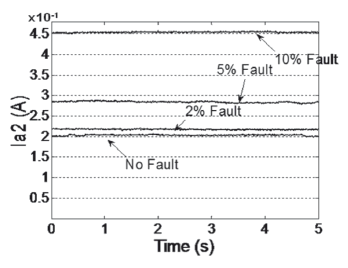
Figure 4. Negative sequence current for no load coupled
Case 2. NSC for stator winding short with 75 % load coupled
In this case, a constant 75 % of the rated current load is applied to the induction motor, and also, stator windings short faults of 2 %, 5 %, and 10 % are induced once again. Experimental results of negative sequence current are shown in Fig. 5, where a baseline for the no fault condition is also depicted.
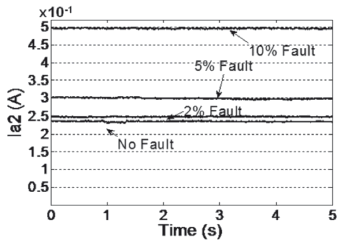
Figure 5. Negative sequence current for 75 % load coupled
Comparing Fig. 4 and Fig. 5, an increase of Ia2 for all fault conditions, including no fault condition can be appreciated. Nevertheless, all Ia2 magnitudes in Fig. 5 present an approximately even increase compared to the values shown in Fig. 4. This means that a roughly relationship between the load level and the NSC fault indicator Ia2 might be established.
Case 3. NSC for stator winding short with 85% load coupled
Figure 6 shows the experimental results of the negative sequence current under a higher load condition for the same fault conditions. As in previous experimental results, the amplitude of the negative sequence current increases as the fault condition becomes severer. The reliable performance of the sequence components in this application is also demonstrated for this test condition.
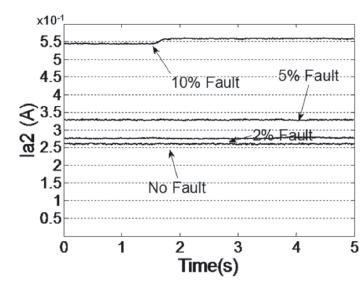
Figure 6. Negative sequence current for 85 % load coupled
The previous experiments allow for us to conclude that there is a slight augmentation in the Ia2 indicator when the load is coupled to the induction motor. This means that there is not a single Ia2 value for the healthy condition, but it depends on the load, and so the Ia2 magnitude for all faulty conditions. Table I presents the Ia2 mean values for all the cases and load conditions.
Table 1. Ia2 Magnitudes for different levels of load and fault severity

4. CONCLUSIONS
In this paper, two noninvasive techniques, MCSA and NSC for induction motor fault detection were implemented and evaluated for several load conditions and fault severities.
For the laboratory test conditions, the MCSA allows for using only one fault frequency magnitude as a fault indicator. The behavior of that frequency was consistent with the expected results in most of the fault case studies. However, the performance of the MCSA technique is degraded by the increment of the load directly modifying the amplitude of the fault indicator. Additionally, and as reported by many studies, the frequencies associated with this type of fault depend on the particular conditions of the motor.
Furthermore, experimental study shows that the NSC diagnosis approach is not immune to load fluctuation either. Conversely, NSC shows a better performance in fault detection and it might be capable of diagnosing the severity level of the stator winding short fault if a load condition-negative sequence current relationship is previously established. For all the tests carried out, the fault is identified promptly and properly using NSC. This method showed its efficacy in performing fault detection when the induction motor is running under different conditions of load and with different levels of severity of the stator winding short fault. However, in order to guarantee a reliable and robust fault detection, power quality must be guaranteed in the motor supply network since the negative sequence current indicator is a reflection of unbalances, not all caused by stator shorted windings.
REFERENCES
[1] Benbouzid, M.E.H., A review of induction motors signatures analysis as a medium for fault detection, IEEE Transactions on Industrial Electronics, Vol. 47, (5), pp. 984-993, 2000. [ Links ]
[2] Quiroga , J., Cartes, D. and Edrington, C., Neural Network Based System Identification of a PMSM Under Load Fluctuation. Revista Dyna, Vol. 76, no. 160, pp. 273-282, 2009. [ Links ]
[3] Albizu, I., Zamora, I., Mazon, A.J. and Tapia, A., Techniques for Online Diagnosis of Stator Shorted Turns in Induction Motors, Electric Power Components and Systems, Vol. 34, (1), pp. 97-114. 2006. [ Links ]
[4] Pereira, L.A., Gazzana, da Silva D. and Pereira, L.F.A., Motor current signature analysis and fuzzy logic applied to the diagnosis of short-circuit faults in induction motors, Industrial Electronics Society, 2005. IECON 2005. 31st Annual Conference of IEEE ,Vol 6, pp. 6-10 Noviembre 2005. [ Links ]
[5] Royo, J. and Arcega, F.J., Machine Current Signature Analysis as a Way for Fault Detection in Squirrel Cage Wind Generators, IEEE International Symposium on Diagnostics for Electric Machines, Power Electronics and Drives, SDEMPED 2007, pp. 383- 387, Septiembre 2007. [ Links ]
[6] Gazzana, D., da Silva. and Pereira, L.A., Fernandes, D., A system for incipient fault detection and fault diagnosis based on MCSA, Transmission and Distribution Conference and Exposition, 2010 IEEE PES , pp.1-6, Abril 2010. [ Links ]
[7] Thomson, W.T., On-line MCSA to diagnose shorted turns in low voltage stator windings of 3-phase induction motors prior to failure, Electric Machines and Drives Conference, IEMDC 2001. IEEE International, pp. 891-898, Junio 2001. [ Links ]
[8] Ojo O., Osaloni, O. and Kshirsagar, P., Models for the control and simulation of synchronous type machine drives under various fault conditions, in 2002 Conference Record Ind. Applicat. Conference, 37th IAS Annual Meeting, Vol. 3, pp. 1533-1540, Diciembre 2002. [ Links ]
[9] Awadallah, M.A. and Morcos, M. M., ANFIS-based diagnosis and location of stator interturn faults in PM brushless DC motors, IEEE Trans. Energy Conversion, Vol. 19, no. 4, pp. 795-796, 2004. [ Links ]
[10] Nelson, A.l. and Chow, M.Y., Characterization of coil faults in an axial flux variable reluctance PM motor, IEEE Trans. Energy Conversion, Vol. 17, no. 3, pp. 340-348, 2002. [ Links ]
[11] Bonnett, A.H. and Soukup, G.C., Cause and analysis of stator and rotor failures in three -phase squirrel cage induction motors, IEEE Transaction on Industry Applications, pp. 921-937, 1992. [ Links ]
[12] Nandi, S., Toliyat, H.A. and Xiaodong, L., Condition monitoring and fault diagnosis of electrical motors-a review, IEEE Transaction on Energy Conversion, Vol.20, no.4, pp. 719-729, 2005. [ Links ]
[13] H.Bollen, M. and Gu, I., Interpretation of Symmetrical Components, En: Signal Processing of Power Quality Disturbances, IEEE Press Series on Power Engineering, pp.69-71, 2006. [ Links ]
[14] Williamson, S. and Mirzoian, K., Analysis of cage induction motors with stator windings faults, IEEE Trans. Power App. Syst., Vol. PAS-104, no. 7, pp. 1832-1842, 1985. [ Links ]














